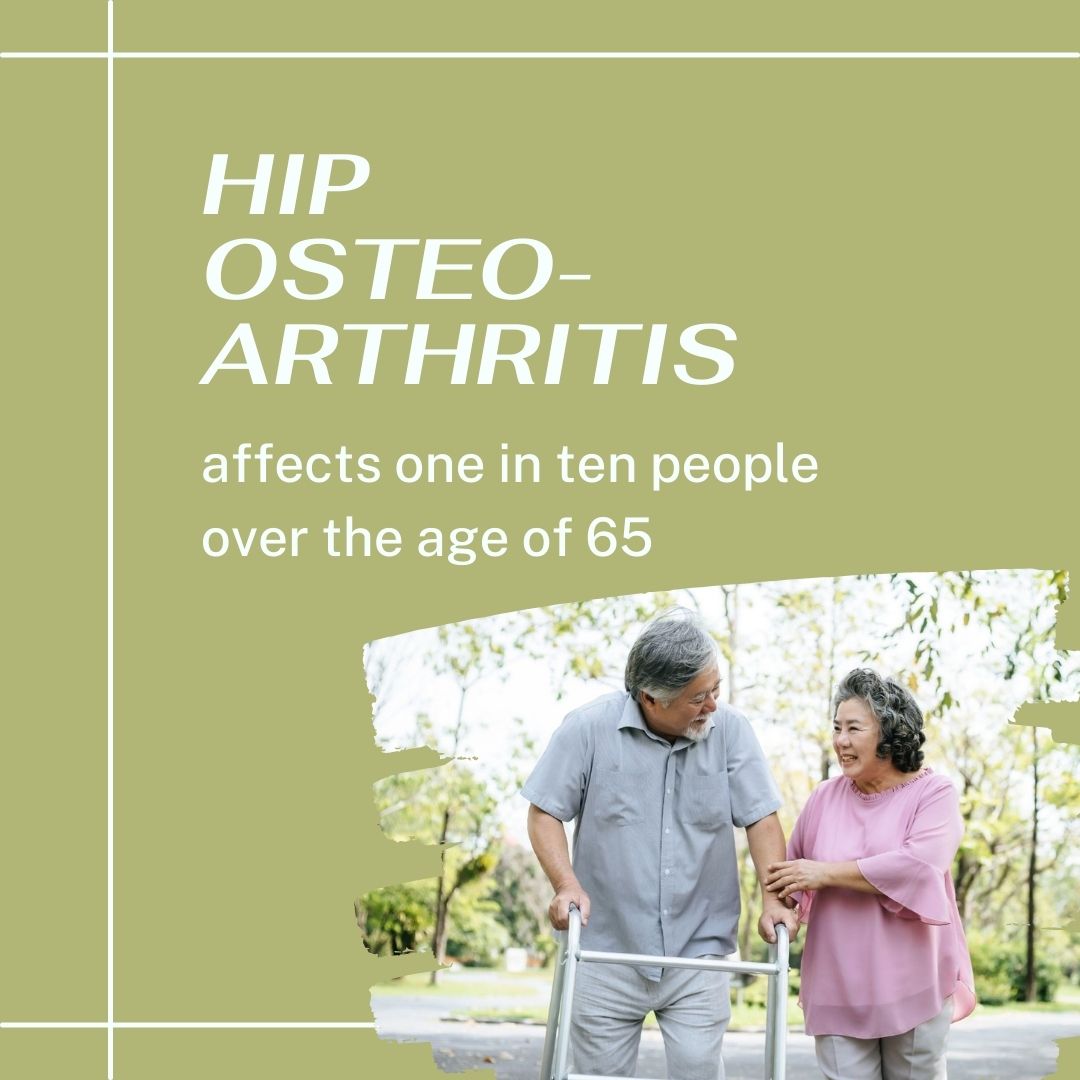What causes hip osteoarthritis?

Osteoarthritis is a result of a gradual degeneration of the cartilage that lines the ends of bones that join to form joints. There is no one specific cause. Almost any joint in the body can develop osteoarthritis, but load-bearing joints (such as the knees, hips and spine) are the most susceptible.
One in ten people over the age of 65 will experience hip osteoarthritis, although it can develop from the age of 45 (it is highly unlikely, but not impossible, to develop earlier).
If you have a family history of osteoarthritis, have had a hip injury or hip function problems in the past, are overweight or have a job that involves long periods of standing or heavy lifting, then you are at increased risk of osteoarthritis.
What are the symptoms of hip osteoarthritis?
Hip osteoarthritis thins the cartilage of the hip joint and makes the surfaces of the hip joint rougher. This can lead to pain and swelling in the area.
People with hip osteoarthritis often experience at least some of the following:
● Progressively increasing pain in the hip
● Pain felt with movement (although it may ease off with continued movement) and at rest
● Pain that is aggravated by cold weather
● Pain in the groin or thigh that radiates to the buttocks or knees
● Stiffness of the hip or a “locking” sensation in the joint
● Decreased range of motion or an affected walking pattern (i.e. limp)
However, approximately 50% of patients with hip osteoarthritis do not have these symptoms, so any changes in your movement as you get older are worth getting checked out, just in case.
How can hip osteoarthritis be treated?
One of the most effective ways to treat osteoarthritis is with exercise. We can work with you to develop an exercise program that will strengthen the muscles around your hip, stabilise and protect the joint, increase your range of motion, improve your posture and reduce any additional strain on the joint.
We will also take a look at the physical activities you are doing day-to-day, and advise you how best to structure them so that you are keeping your hip moving but not overdoing it. It’s important to keep moving when you have osteoarthritis, but breaking up physical tasks into chunks rather than doing too much at once can help to reduce the pressure on your joints. There may also be insoles, walking aids or other forms of supportive equipment that we can recommend to take stress off your hip, as well as changes to your lifestyle and home/work set-up that may help.
Manual therapy and massage are also frequently used to reduce pain and increase movement. Massage may include myofascial trains and dry needling to improve the 'slings' across the hip and pelvis. Additionally, Muscle Energy Techniques are also employed aiming to re-align the pelvis and hips.
When it comes to osteoarthritis of any kind, the sooner you get treatment, the better. In the worst-case scenario, hip osteoarthritis could require surgery or even a total hip replacement. So come and see us early before the pain gets too severe.
How can hip osteoarthritis be prevented?
The sooner you start to look after your hips, the more you can reduce your risk of developing osteoarthritis. Here are a few things you can start doing right now:
● Regular exercises to strengthen the muscles around the joint and stretching to improve mobility will help to protect the hip from degeneration.
● Make sure you always use the correct technique to lift heavy items, and don’t lift excessive loads.
● Maintain a healthy weight, as obesity puts strain on your hips.
● If you are sitting for long periods of time, ensure that your chair provides adequate support and that your hips are slightly higher than your knees. Try to avoid crossing your legs. Take regular breaks to move around. Do lots of 'buttock ups'
Diet
Diet can be very useful in preventing and ameliorating osteoarthritis. Simple weight loss programs such as the 16 : 8 diet (fasting 16 hours whilst eating lunch and dinner), can lead to weight loss, but may also be aimed at reducing cholesterol. As we know cholesterol can block the arteries. As the joints are at the end of the circulatory chain, then even minor blockages can be a problem. we also know that many tendinosis/bursitis in the hip may be due to immune-metabolic compromise.
Supplementations have been controversial, however 1000mg of EPA/DHA fish oil have been recommended, as have New Zealand green lip muscles, forest berry and cherry anti-oxidants. Apart from the anti-oxidant properties, fish oil has an effect on blood viscosity. Additionally, if glucosamine is taken, the minimal dose is 1200mg glucosamine with 800mg MSM and 800mg of Chondroitin. However, the latter may have an effect on any thyroid issues.
Further Reading : https://www.back-in-business-physiotherapy.com/we-do/nutritional-supplementation.html
References
1. Physiopedia. 2021. Hip Osteoarthritis [Onlinehttps://www.physio-pedia.com/Hip_Osteoarthritis
2. OrthoInfo. 2021. Osteoarthritis of the Hip [Onlinehttps://orthoinfo.aaos.org/en/diseases--conditions/osteoarthritis-of-the-hip
Uploaded : 25 November 2021




